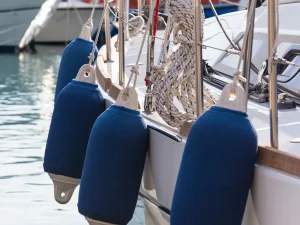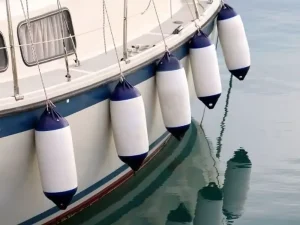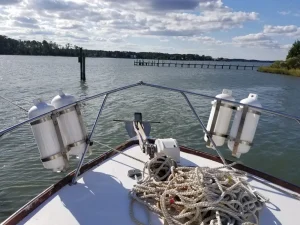Fender schützen die Boote und großen Schiffe wirksam. Wenn ihre Größe jedoch ungenau ist, kann ihre Wirksamkeit beeinträchtigt werden. Auf die richtige Größe kommt es an wenn es um Kotflügel geht. Die Menschen scheinen bei der Wahl der richtigen Fendergröße zwiegespalten zu sein. Sie fragen sich: Welche Größe brauche ich für Bootsfender?
Interessanterweise gibt es keine Einheitsgröße, die für alle Boote passt. Stattdessen variiert die Größe der Fender je nach Größe der Boote und Schiffe. Kleine Boote brauchen kleine Fender, und umgekehrt. In diesem Artikel werde ich die Fendergröße für verschiedene Schiffe erklären. Am Ende werden Sie wissen, wie Sie die richtige Größe der Fender auswählen können. Also, fangen wir an!
Warum ist die richtige Größe bei der Auswahl von Bootsfendern wichtig?

Die richtige Größe des Kotflügels sorgt für optimalen Schutz. Wenn die Größe des Schutzblechs nicht stimmt, bringt die Verwendung eines Schutzblechs nichts. Lassen Sie uns besprechen, warum ich die Fendergröße betone:
- Ein kleiner Fender wird den starken Aufprall niemals auffangen. Das Boot selbst wird dem Ruck ausgesetzt sein, anstatt dass die Fender die Energie absorbieren.
- Der kleine Fender deckt möglicherweise nicht den ausreichenden Bereich des Schiffes ab. Daher kann es passieren, dass das Schiff bei der Annäherung an das Dock mit der Andockstruktur statt mit dem Fender kollidiert. In solchen Fällen wird das Schiff zerkratzt und verbeult.
- Übergroße Fender können zu Stabilitätsproblemen führen, insbesondere beim Anlegen. So kann ein Boot beispielsweise immer wieder verrutschen, wenn der Fender zu groß ist. Außerdem können sperrige Fender einen unnötigen Widerstand erzeugen.
- Die Aufbewahrung der großen Fender kann ein großes Problem sein. Stellen Sie sich vor, Sie transportieren einen großen Fender auf einem relativ kleinen Boot. Der Fenderstauraum reicht möglicherweise nicht aus, um einen so sperrigen Fender zu verstauen. Infolgedessen kann es zu Platzproblemen kommen, da die Fender mehr Platz benötigen.
Welche Größe von Bootsfendern benötige ich?

Für ein Boot von bis zu 10 Fuß benötigen Sie einen 10- bis 12-Zoll-Fender. Bei einer Bootsgröße von 20 bis 25 Fuß muss Ihr Fender 18 bis 22 Zoll groß sein. Die Größe des Fenders nimmt mit der Größe des Bootes zu. Je 10 Fuß mehr Bootsgröße sollten Sie den Fender um etwa 4 bis 6 Zoll vergrößern. Dies ist ein grober Richtwert und kann leicht variieren.
Zweitens werden Sie sich vielleicht über den Durchmesser des Kotflügels wundern. Das ist die Breite oder Dicke des Kotflügels. Ein größerer Durchmesser bedeutet, dass der Fender mehr Kraft oder Aufprall absorbieren kann. Für ein Boot von 10 Fuß sollten Sie einen Fender mit einem Durchmesser von 3 bis 4 Zoll wählen. Für ein 20-Fuß-Boot sollten Sie einen Fender mit einem Durchmesser von 6 Zoll wählen.
Hier ist eine Tabelle mit der Fender-Größentabelle:
| Boot Länge | Fender-Durchmesser | Fender Länge |
| 10 Fuß | 3-4 Zoll | 10-12 Zoll |
| 10-20 Fuß | 4-5 Zoll | 12-18 Zoll |
| 20-30 Fuß | 6-8 Zoll | 18-24 Zoll |
| 30-40 Fuß | 8-10 Zoll | 24-28 Zoll |
| 40-50 Fuß | 10-12 Zoll | 28-36 Zoll |
Denken Sie daran, dass es keine Einheitsgröße gibt, die für alle Arten und Größen von Booten geeignet ist. Die Fendergröße, die Sie wählen sollten, hängt von verschiedenen Faktoren ab. Dazu gehören die Bootsgröße, das Bootsgewicht, die Wasserbeschaffenheit, der Anlegestil und der Stauraum am Boot. Die Analyse dieser Faktoren kann Ihnen helfen, die richtige Auswahl an Bootsfendern zu treffen.
Faktoren, die die Fendergröße beeinflussen

Wie ich bereits sagte, beeinflussen mehrere Faktoren die Größe des Kotflügels. Lassen Sie uns jeden dieser Faktoren im Detail besprechen:
- Länge des Bootes: Die Größe der Boote spielt eine entscheidende Rolle bei der Auswahl von Bootsfendern. Je größer das Boot, desto größer muss der Fender sein. Und warum? Weil solche Boote eine größere Oberfläche haben, die mit Anlegestrukturen kollidieren kann. Große Fender gewährleisten also die Sicherheit des Bootes.
- Gewicht des Bootes: Das Gewicht des Bootes ist ein weiterer entscheidender Faktor. Wenn das Boot zu schwer ist, wird ein größerer Fender benötigt. Lassen Sie mich den Grund dafür erklären. Beim Aufprall auf die Anlegestelle ist das schwere Boot einer größeren Aufprallkraft ausgesetzt. Ein größerer Fender kann daher den extremen Aufprall leicht abfangen und die Sicherheit des Bootes gewährleisten.
- Fender Typ: Wie Sie wissen, gibt es verschiedene Arten von Schutzblechen, die sich im Durchmesser unterscheiden. Zylindrische Fender haben beispielsweise einen mittleren Durchmesser und sind für den allgemeinen Gebrauch geeignet. Runde Fender hingegen haben einen großen Durchmesser und sind daher ideal für große Boote und Schiffe. Die flachen Fender mit kleinen Durchmessern sind für kleine Boote geeignet.
- Anlege- oder Liegeplatzbedingungen: Diese Anlegebedingungen wirken sich auch auf die Größe des Fenders aus, den Sie wählen. Wenn Sie zum Beispiel ein Boot in einem belebten und überfüllten Hafen anlegen, sollten Sie größere Fender wählen. Die Gefahr eines Zusammenstoßes ist in solchen Häfen groß. Ein größerer Fender deckt also alle wichtigen Punkte des Bootes ab. Auf diese Weise stellen sie sicher, dass Boote und Schiffe in der Nähe nicht zusammenstoßen und das Boot beschädigen.
Wie viele Schutzbleche brauchen Sie?
Man hört oft, dass man beim Anlegen möglichst viele Fender benutzen soll. Ist dieser Ansatz richtig? Die Antwort lautet NEIN! Wie viele Fender sollten Sie also beim Anlegen oder Festmachen verwenden?
Sie sollten zwei Fender auf einer Seite verwenden, wenn das Boot 10 Fuß lang ist. Bei einem 10-Fuß-Boot sollten Sie beim Anlegen vier Fender (zwei auf jeder Seite) verwenden. Überladen Sie das Boot nicht mit Fendern, sonst kann es beim Anlegen unangenehm auffallen. Das Schiff kann rutschen und schleifen, weil es mehrere Fender hat.
Wie viele Fender ein Boot verwenden sollte, hängt hauptsächlich von seiner Größe ab. Andere Faktoren, wie die Anlegebedingungen und das Gewicht des Bootes, sollten ebenfalls berücksichtigt werden. Denken Sie daran, dass die Platzierung der Fender wichtiger ist als die Anzahl der Fender. Stellen Sie sich ein 10-Fuß-Boot mit vier strategisch angebrachten Fendern vor.
Diese korrekte Platzierung ist besser als acht Fender auf demselben Boot. Es kommt auf die Platzierung der Fender an und nicht auf die Anzahl. Hier ist die Tabelle, die die richtige Anzahl von Fendern auf den Schiffen zeigt:
| Boot Länge | Kotflügel (pro Seite) | Kotflügel insgesamt (beide Seiten) |
| Bis zu 10 Fuß | 2 Schutzbleche | 3 Schutzbleche |
| Bis zu 20 Fuß | 3 Schutzbleche | 6 Schutzbleche |
| 20-30 Fuß | 4 Kotflügel | 8 Kotflügel |
| 30-40 Fuß | 5 Kotflügel | 10 Schutzbleche |
| 40-50 Fuß | 6 Schutzbleche | 12 Kotflügel |
Welchen Einfluss hat der Durchmesser der Kotflügel auf die Leistung?
Der Durchmesser gibt die Dicke des Kotflügels an. Ein Fender mit einem größeren Durchmesser hat beispielsweise eine größere Dicke und umgekehrt. Ein dickerer Fender kann mehr Aufprallkraft absorbieren, so dass er auch bei schweren oder überladenen Booten effektiv arbeiten kann.
Auf der anderen Seite sind Kotflügel mit kleinem Durchmesser vergleichsweise schwächer. Ihre Stoßdämpfung ist nicht sehr gut. Daher sind solche Fender nur für kleine Boote geeignet. Bei der Wahl eines Bootsfenders empfehle ich, Fender mit einem angemessenen Durchmesser zu wählen. Dadurch wird sichergestellt, dass Ihr Boot beim Aufprall auf die Anlegestelle sicher bleibt.
Welches ist das ideale Verhältnis von Länge zu Durchmesser bei Kotflügeln?
Das ideale Verhältnis von Länge zu Durchmesser beträgt 3:1 bis 5:1.
Das bedeutet, dass ein 3 Zoll langer Kotflügel einen Durchmesser von 1 Zoll haben sollte. Es bedeutet auch, dass 10 bis 12 Zoll lange Durchmesser aus 3 bis 4 Zoll Durchmesser bestehen sollten. Denken Sie daran, dass ein angemessener Durchmesser eine bessere Leistung des Kotflügels gewährleistet. Wenn der Durchmesser klein und die Länge groß ist, kann es sein, dass der Fender nicht optimal funktioniert.
Umgekehrt schützt ein Fender mit geringer Länge, aber großem Durchmesser das Boot nicht wirksam. Es muss ein Gleichgewicht zwischen dem Durchmesser und der Länge der Fender bestehen. Wenn Sie einen Fender kaufen, sollten Sie seinen Durchmesser sorgfältig prüfen. Lange Fender mit optimalem Durchmesser sollten die beste Wahl sein.
Häufig gestellte Fragen
Wie lang sollten Bootsfender sein?
Die Größe des Bootsfenders hängt von der Größe des Bootes ab. Für ein größeres Boot wird ein großer Fender benötigt und umgekehrt. Im Allgemeinen sollten Sie einen 10-Zoll-Fender für ein Schiff von 10 Fuß Länge verwenden.
Wie viele Fender braucht man für ein 20 Fuß langes Boot?
In der Regel reichen 12 Fender für ein Boot von 20 Fuß Länge. Denken Sie daran, dass die Anzahl der Fender vom Gewicht des Bootes abhängt. Wenn Sie ein schweres Schiff manövrieren, empfehle ich Ihnen, mehr Fender zu verwenden, d. h. 18 bis 20.
Kann ich verschiedene Fendergrößen auf einem Boot verwenden?
Ja, Sie können sie verwenden, aber ich empfehle sie nicht. Unterschiedliche Größen von Fendern auf einem Boot funktionieren möglicherweise nicht effektiv. Sie sollten einen Fender der gleichen Größe verwenden, der den wichtigsten Punkt des Bootes abdeckt.
Schlussfolgerung
Fender sind entscheidend für die Sicherheit und Unversehrtheit von Booten und Schiffen. Wenn sie jedoch die falsche Größe haben, können sie das Boot nicht wirksam schützen. Denken Sie daran, Fenderhersteller bieten individuelle Fender an Größen.
Das bedeutet, dass Sie die Größe bestellen können, die perfekt zu Ihren Booten passt. Außerdem müssen Sie Ihr Boot nicht mit Fender überladen. Nur wenige Fender können gute Dienste leisten, wenn sie an den richtigen Stellen angebracht werden. Es gibt keine feste Regel, wie viele Fender Sie auf einem Boot verwenden sollten. In diesem Artikel habe ich alles über die Fendergrößen und ihre Auswahl erklärt.
